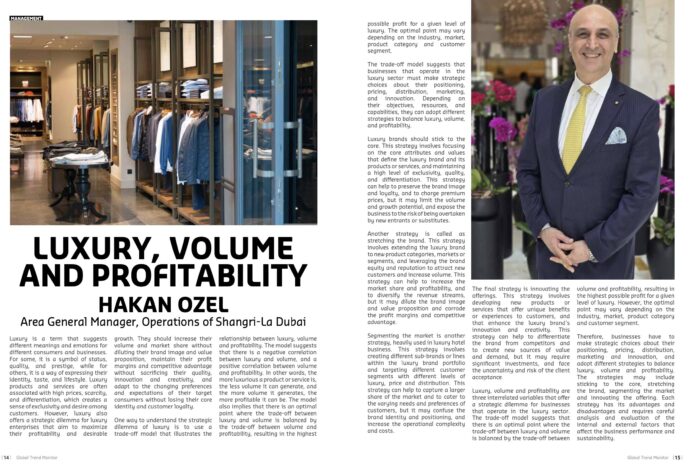Hakan Ozel, Area General Manager, Operations of Shangri-La Dubai
Luxury is a term that suggests different meanings and emotions for different consumers and businesses. For some, it is a symbol of status, quality, and prestige, while for others, it is a way of expressing their identity, taste, and lifestyle. Luxury products and services are often associated with high prices, scarcity, and differentiation, which creates a sense of exclusivity and desire among customers. However, luxury also offers a strategic dilemma for luxury enterprises that aim to maximize their profitability and desirable growth. They should increase their volume and market share without diluting their brand image and value proposition, maintain their profit margins and competitive advantage without sacrificing their quality, innovation and creativity, and adapt to the changing preferences and expectations of their target consumers without losing their core identity and customer loyalty.
One way to understand the strategic dilemma of luxury is to use a trade-off model that illustrates the relationship between luxury, volume and profitability. The model suggests that there is a negative correlation between luxury and volume, and a positive correlation between volume and profitability. In other words, the more luxurious a product or service is, the less volume it can generate, and the more volume it generates, the more profitable it can be. The model also implies that there is an optimal point where the trade-off between luxury and volume is balanced by the trade-off between volume and profitability, resulting in the highest possible profit for a given level of luxury. The optimal point may vary depending on the industry, market, product category and customer segment.
The trade-off model suggests that businesses that operate in the luxury sector must make strategic choices about their positioning, pricing, distribution, marketing, and innovation. Depending on their objectives, resources, and capabilities, they can adopt different strategies to balance luxury, volume, and profitability.
Luxury brands should stick to the core. This strategy involves focusing on the core attributes and values that define the luxury brand and its products or services, and maintaining a high level of exclusivity, quality, and differentiation. This strategy can help to preserve the brand image and loyalty, and to charge premium prices, but it may limit the volume and growth potential, and expose the business to the risk of being overtaken by new entrants or substitutes.
Another strategy is called as stretching the brand. This strategy involves extending the luxury brand to new product categories, markets or segments, and leveraging the brand equity and reputation to attract new customers and increase volume. This strategy can help to increase the market share and profitability, and to diversify the revenue streams, but it may dilute the brand image and value proposition and corrode the profit margins and competitive advantage.
Segmenting the market is another strategy, heavily used in luxury hotel business. This strategy involves creating different sub-brands or lines within the luxury brand portfolio and targeting different customer segments with different levels of luxury, price and distribution. This strategy can help to capture a larger share of the market and to cater to the varying needs and preferences of customers, but it may confuse the brand identity and positioning, and increase the operational complexity and costs.
The final strategy is innovating the offerings. This strategy involves developing new products or services that offer unique benefits or experiences to customers, and that enhance the luxury brand’s innovation and creativity. This strategy can help to differentiate the brand from competitors and to create new sources of value and demand, but it may require significant investments, and face the uncertainty and risk of the client acceptance.
Luxury, volume and profitability are three interrelated variables that offer a strategic dilemma for businesses that operate in the luxury sector. The trade-off model suggests that there is an optimal point where the trade-off between luxury and volume is balanced by the trade-off between volume and profitability, resulting in the highest possible profit for a given level of luxury. However, the optimal point may vary depending on the industry, market, product category and customer segment. Therefore, businesses have to make strategic choices about their positioning, pricing, distribution, marketing and innovation, and adopt different strategies to balance luxury, volume and profitability. The strategies may include sticking to the core, stretching the brand, segmenting the market and innovating the offering. Each strategy has its advantages and disadvantages and requires careful analysis and evaluation of the internal and external factors that affect the business performance and sustainability.
